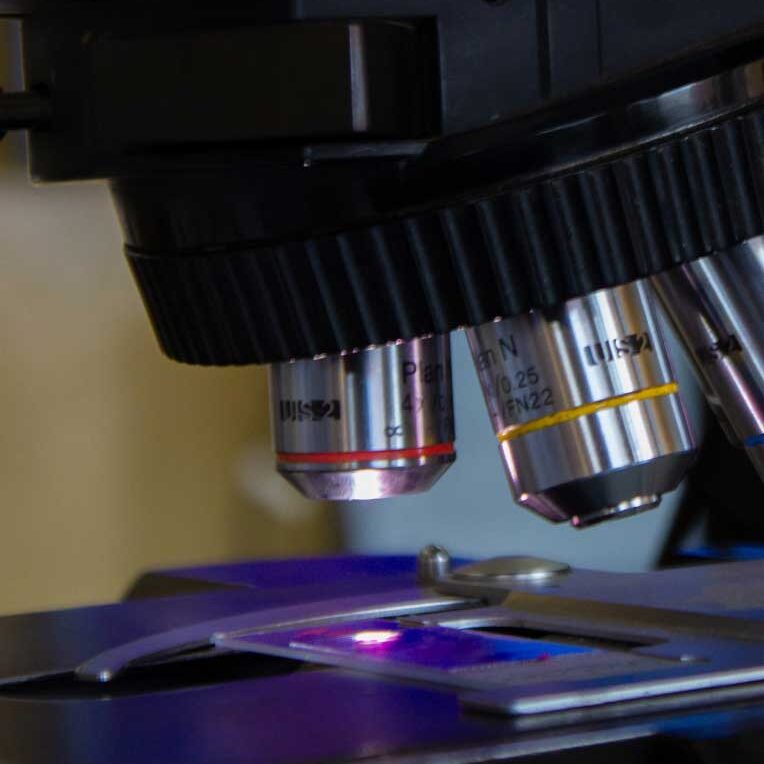Jean-Pierre Roussarie
Biography
When Jean-Pierre Roussarie was born, his father was studying particle physics at Stanford University, so Dr. Roussarie spent his first two years of life in Northern California before his family moved back to France, just outside of Paris. He also spent a lot of time in Switzerland, where his mother was from.
Both of Dr. Roussarie’s parents were scientists. The two met when they were working on their Ph.D.s in the same lab, studying an elementary particle called a Z0 boson. Because of this, Dr. Roussarie was exposed to science at a young age. He remembers asking a lot of questions about the world, and always appreciated how his parents could make even the most complicated ideas accessible. Dr. Roussarie had a passion for learning and loved all subjects in school —from literature and languages to math and science. He also enjoyed music and played the clarinet.
Dr. Roussarie attended a high school that taught in both French and German. He graduated with very high honors and moved onto Preparatory School, where he spent two intense years preparing for engineering school. He then attended and earned his BS from the Ecole Polytechnique (Polytechnical School), the leading engineering school in France.
Rather than continuing to study engineering, Dr. Roussarie decided to pivot to biology, earning his Master’s and Ph.D. in Fundamental Virology from the Université Paris VI Pierre et Marie Curie (Pierre and Marie Curie University). This decision was influenced by his fascination with the subject as well as the experience of his father, who had been struggling with cognitive and memory issues following a debilitating cardiac arrest he had when Dr. Roussarie was only a teenager.
For his thesis research, Dr. Roussarie studied Theiler’s Virus — a virus that triggers a Multiple Sclerosis–like disease in mice — with Dr. Michel Brahic. He completed his training at Rockefeller University, where he started to work on

Alzheimer’s disease under the supervision of the late Nobel Prize winner Dr. Paul Greengard.
Today, Dr. Roussarie is an Assistant Professor of Anatomy and Neurobiology at the Boston University Chobanian and Avedisian School of Medicine. His lab focuses on deciphering the molecular events leading to neurodegeneration in Alzheimer’s disease. Like most neurodegenerative diseases, Alzheimer’s affects only very specific sets of neurons in its earliest stages. These neurons are located in the entorhinal cortex, a brain region indispensable for new memory formation. Dr. Roussarie thinks that understanding the particularities of these entorhinal cortex neurons will yield novel insights into the pathological processes of Alzheimer’s disease. Eventually, this will lead to the identification of new therapeutic targets to prevent neurodegeneration. In order to elucidate the properties of entorhinal neurons at single-cell resolution, the Roussarie lab uses a combination of mouse models, human postmortem tissue, novel in vitro culture protocols, and in silico modeling.
“The biology of Alzheimer's is so intertwined with the biology of memory. I think that when we discover the particularities of entorhinal neurons that make them vulnerable to Alzheimer's disease, we will also learn a lot about the normal processes happening when we're forming new memories, which is still something we know so little about.”
– Dr. Jean-Pierre Roussarie

Biography
When Jean-Pierre Roussarie was born, his father was studying particle physics at Stanford University, so Dr. Roussarie spent his first two years of life in Northern California before his family moved back to France, just outside of Paris. He also spent a lot of time in Switzerland, where his mother was from.
Both of Dr. Roussarie’s parents were scientists. The two met when they were working on their Ph.D.s in the same lab, studying an elementary particle called a Z0 boson. Because of this, Dr. Roussarie was exposed to science at a young age. He remembers asking a lot of questions about the world, and always appreciated how his parents could make even the most complicated ideas accessible. Dr. Roussarie had a passion for learning and loved all subjects in school —from literature and languages to math and science. He also enjoyed music and played the clarinet.
Dr. Roussarie attended a high school that taught in both French and German. He graduated with very high honors and moved onto Preparatory School, where he spent two intense years preparing for engineering school. He then attended and earned his BS from the Ecole Polytechnique (Polytechnical School), the leading engineering school in France.
Rather than continuing to study engineering, Dr. Roussarie decided to pivot to biology, earning his Master’s and Ph.D. in Fundamental Virology from the Université Paris VI Pierre et Marie Curie (Pierre and Marie Curie University). This decision was influenced by his fascination with the subject as well as the experience of his father, who had been struggling with cognitive and memory issues following a debilitating cardiac arrest he had when Dr. Roussarie was only a teenager.
For his thesis research, Dr. Roussarie studied Theiler’s Virus — a virus that triggers a Multiple Sclerosis–like disease in mice — with Dr. Michel Brahic. He completed his training at Rockefeller University, where he started to work on Alzheimer’s disease under the supervision of the late Nobel Prize winner Dr. Paul Greengard.
Today, Dr. Roussarie is an Assistant Professor of Anatomy and Neurobiology at the Boston University Chobanian and Avedisian School of Medicine. His lab focuses on deciphering the molecular events leading to neurodegeneration in Alzheimer’s disease. Like most neurodegenerative diseases, Alzheimer’s affects only very specific sets of neurons in its earliest stages. These neurons are located in the entorhinal cortex, a brain region indispensable for new memory formation. Dr. Roussarie thinks that understanding the particularities of these entorhinal cortex neurons will yield novel insights into the pathological processes of Alzheimer’s disease. Eventually, this will lead to the identification of new therapeutic targets to prevent neurodegeneration. In order to elucidate the properties of entorhinal neurons at single-cell resolution, the Roussarie lab uses a combination of mouse models, human postmortem tissue, novel in vitro culture protocols, and in silico modeling.
“The biology of Alzheimer's is so intertwined with the biology of memory. I think that when we discover the particularities of entorhinal neurons that make them vulnerable to Alzheimer's disease, we will also learn a lot about the normal processes happening when we're forming new memories, which is still something we know so little about.”
– Dr. Jean-Pierre Roussarie

Research Focus
Challenges
At its earliest stages, Alzheimer’s disease affects only very specific sets of neurons. Before the first clinical symptoms occur, aggregates of the protein tau form almost exclusively in a group of neurons that is central to new memory formation: neurons from layer II of the entorhinal cortex (ECII).
The characterization of these neurons is technically challenging, so not much is known about them. As a result, the cascade of events occurring in the brain’s most vulnerable neurons during the early stages of Alzheimer’s disease, and culminating with neurodegeneration, are also largely elusive. In particular, scientists do not know what genes are driving pathological modifications of tau and its aggregation, a necessary step in the neurodegeneration process.
Focus and Priorities
Dr. Roussarie believes that Alzheimer’s disease should be studied from the perspective of ECII neurons. Understanding why ECII neurons accumulate pathology before any other neuron of the brain will help reveal the mechanisms at play during Alzheimer’s disease. ECII neurons likely have exaggerated disease-associated features, but these same mechanisms might also be at play, to a lesser degree, in other neurons at later stages of the disease. In addition, the search for therapeutic intervention points to inhibit tau pathology in the most vulnerable neurons is essential, since it could help curb the pathology before it spreads to further areas of the brain.
Focus and Priorities
Dr. Roussarie believes that Alzheimer’s disease should be studied from the perspective of ECII neurons. Understanding why ECII neurons accumulate pathology before any other neuron of the brain will help reveal the mechanisms at play during Alzheimer’s disease. ECII neurons likely have exaggerated disease-associated features, but these same mechanisms might also be at play, to a lesser degree, in other neurons at later stages of the disease. In addition, the search for therapeutic intervention points to inhibit tau pathology in the most vulnerable neurons is essential, since it could help curb the pathology before it spreads to further areas of the brain.
To build on a wealth of previous research into ECII neurons, Dr. Roussarie and his team are attempting to identify genes that modulate the levels of tau pathology. Using ECII-like neurons and CRISPR technology, they hope to identify much more potent regulators of tau pathology than what has been shown with generic neurons.
To build on a wealth of previous research into ECII neurons, Dr. Roussarie and his team are attempting to identify genes that modulate the levels of tau pathology. Using ECII-like neurons and CRISPR technology, they hope to identify much more potent regulators of tau pathology than what has been shown with generic neurons.
Benefits
In a future project, Dr. Roussarie and his team will test the top gene candidates in a mouse model of tau pathology to confirm that the candidate genes are indeed modulating vulnerability. This pilot project will provide evidence that ECII-like neurons can identify regulators of tau pathology that are more potent and of higher therapeutic relevance for Alzheimer’s disease than generic neurons would. It will also open the door to many exciting developments. The team’s results will generate material for a future ambitious R01 grant proposal screening for genes involved in a number of other tau modifications.
They hope their work will eventually lead to the identification of new therapeutic targets to prevent neurodegeneration.
Karen Toffler Charitable Trust Investment
Funding from the Karen Toffler Charitable Trust will be used to screen for genes that are involved in Alzheimer’s disease. New technologies based on CRISPR allow Dr. Roussarie to modulate the level of different genes. After adjusting the level of various genes, Dr. Roussarie and his team will look at the amount of tau protein that has accumulated in each scenario. This will enable them to determine the genes that, when increased, drive tau accumulation. These genes will be good targets to disrupt the disease at its earliest stages.
Karen Toffler Charitable Trust Investment
Funding from the Karen Toffler Charitable Trust will be used to screen for genes that are involved in Alzheimer’s disease. New technologies based on CRISPR allow Dr. Roussarie to modulate the level of different genes. After adjusting the level of various genes, Dr. Roussarie and his team will look at the amount of tau protein that has accumulated in each scenario. This will enable them to determine the genes that, when increased, drive tau accumulation. These genes will be good targets to disrupt the disease at its earliest stages.
“Trying to understand the vulnerability of ECII neurons is our overarching goal, but it's an ambitious goal. There are steps we need to take to reach that goal, including mapping the region of the brain where ECII neurons are located and learning how to grow in vitro cultures of ECII-like neurons. We are very happy with the progress we are making, and hope that this body of work will eventually lead to the identification of new therapeutic targets to prevent neurodegeneration.”
– Dr. Jean-Pierre Roussarie